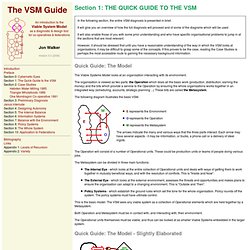

Structuring Companies for Innovation and Operations. The appropriate structuring of companies is becoming more and more relevant as a mechanism for managing and enhancing their innovation capability. This article explores the concept of the Viable Systems Model (VSM) of Stafford Beer as a tool to better structure organisations for effective innovation and efficient operation. Traditionally hierarchical and silo’ed structures are simply too cumbersome to deal with the modern imperatives of flexibility, integration and agility. Regular and transparent communication, of both the formal and informal kind, is generally lacking. This stifles innovation. Ask just about any person who works for a large corporate environment about the structure of their organisation. Matrix and other alternative structures have been instigated in companies to try and improve upon the inflexible, disconnected and opaque nature of these traditional structures and have proved useful at certain levels.
The need for ambidexterity Basics of a “viable” system. 257 (application/pdf Object) Viplan.pdf (application/pdf Object) Viable_System_Model.pdf (application/pdf Object) Stafford Beer - Viable System Model. Management Cybernetics: science of effective organization. Management Cybernetics & Chaos Theory. Viable System Model. Viable system model. Just how much of a law is Ashby’s Law of Requisite Variety?

Our answers to that question – and likely there’ll be many of them – are fundamental to how we handle key architectural concepts or requirements such as management, … Tagged with: ashby's law of requisite variety , Business , business architecture , chaos , complexity , effectiveness , enterprise , Enterprise architecture , Futures , methodology , SCAN , sense-making , strategy , viable system model , vsm Posted in Business , Complexity / Structure , Enterprise architecture One of the more valuable uses of the Enterprise Canvas is as a checklist to verify completeness and viability of services, in any context within the enterprise. By ‘completeness’ I mean that we check that the service has all the … Vsm.pdf (application/pdf Object) INTRODUCTION TO THE VIABLE SYSTEM MODEL3.pdf (application/pdf Object) Systems. When Stafford Beer originally created the Viable Systems Model (VSM) he was seeking to develop a "science of organisation", a set of invariant laws that could be applied to any sort of organisation of any size.

So far, we have not found any organisational context in which it does not apply. It is an approach which helps us to make sense of organisations, or groups of organisations of any degree of complexity and tells us something about how they operate, why they function the way they do and what we might be able to do to change them. The Viable Systems Model has a very different view on how organisations work from conventional approaches and provides radically different answers to many common and intractable management problems.
SCiO members come from a wide variety of disciplines, but share an interest in how organisations work, so this science of organisation is core to SCiO's work. VSM-Intro-Fractal.pdf (application/pdf Object) TheViableSystemModel.pdf (application/pdf Object) The Viable Systems Model Guide 3e. Quick Guide: The Model The Viable Systems Model looks at an organisation interacting with its environment.

The organisation is viewed as two parts: the Operation which does all the basic work (production, distribution, earning the money) and the bits which provide a service to the Operation by ensuring the whole organisations works together in an integrated way (scheduling, accounts, strategic planning ...) These bits are called the Metasystem.
The following diagram illustrates the basic VSM. The Operation will consist of a number of Operational units. The Metasystem can be divided in three main functions: The Internal Eye - which looks at the entire collection of Operational units and deals with ways of getting them to work together in mutually beneficial ways, and with the resolution of conflicts. This is the basic model: The VSM sees any viable system as a collection of Operational elements which are held together by a Metasystem. Quick Guide: The Model - Slightly Elaborated Thus Thus: Designing_freedom.pdf (application/pdf Object)